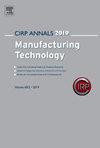通过形状自适应工艺进行表面处理
IF 3.6
3区 工程技术
Q2 ENGINEERING, INDUSTRIAL
引用次数: 0
摘要
复杂表面越来越多地用于光学、生物医学设备和航空航天工业。增材制造和五轴铣削可以生产复杂的形状,但需要额外的精加工工艺来满足表面质量要求。这篇主题论文回顾了在不改变形状的情况下实现均匀表面质量改善的形状自适应整理工艺。分析了影响形状适应性、加工效率和材料适用性的关键因素,讨论了复杂曲面精加工的最佳工艺选择策略。概述了该领域未来的可能性和研究主题,包括过程建模/仿真、数字孪生、表面/地下计量、功能评估以及先进机器人和人工智能的应用。本文章由计算机程序翻译,如有差异,请以英文原文为准。
Surface finishing by shape-adaptive processes
Complex surfaces are increasingly used in optics, biomedical devices, and aerospace industries. Additive manufacturing and five-axis milling can produce complex shapes, but additional finishing processes are needed to meet the surface quality demands. This keynote paper reviews shape-adaptive finishing processes that enable uniform surface quality improvement without altering the shape. Key factors affecting shape adaptability, processing efficiency, and material applicability are analyzed and optimal process selection strategies for finishing complex surfaces are discussed. Future possibilities and research topics in this area, including process modeling/simulation, digital twin, surface/subsurface metrology, functionality evaluation, and applications of advanced robotics and artificial intelligence, are outlined.
求助全文
通过发布文献求助,成功后即可免费获取论文全文。
去求助
来源期刊

Cirp Annals-Manufacturing Technology
工程技术-工程:工业
CiteScore
7.50
自引率
9.80%
发文量
137
审稿时长
13.5 months
期刊介绍:
CIRP, The International Academy for Production Engineering, was founded in 1951 to promote, by scientific research, the development of all aspects of manufacturing technology covering the optimization, control and management of processes, machines and systems.
This biannual ISI cited journal contains approximately 140 refereed technical and keynote papers. Subject areas covered include:
Assembly, Cutting, Design, Electro-Physical and Chemical Processes, Forming, Abrasive processes, Surfaces, Machines, Production Systems and Organizations, Precision Engineering and Metrology, Life-Cycle Engineering, Microsystems Technology (MST), Nanotechnology.
 求助内容:
求助内容: 应助结果提醒方式:
应助结果提醒方式:


